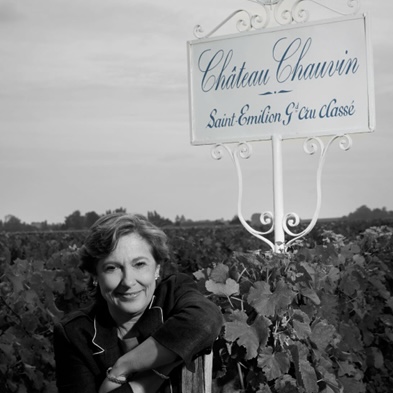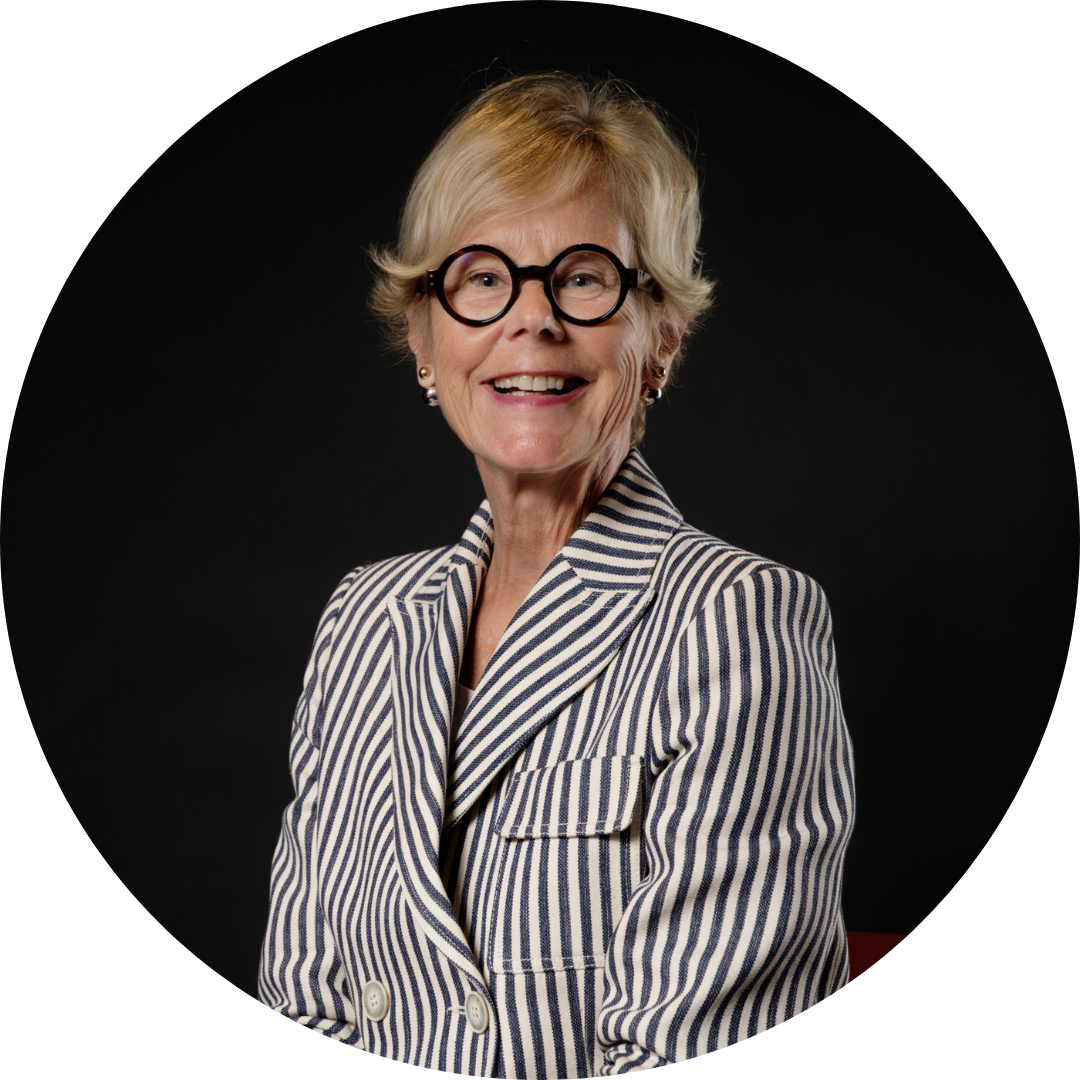Sylvie Cazes
Owner
~
Château Chauvin
Saint Emilion Grand Cru Classé
Sylvie Cazes is a leading figure in the world of wine, both in Bordeaux and internationally. In 2013, she and her children Julie, François and Pierre purchased the Saint-Émilion Grand Cru Classé, Château Chauvin. Sylvie also remains co-owner of Châteaux Lynch-Bages, Haut-Batailley and Les Ormes de Pez. In addition, she owns the restaurant Le Chapon Fin in Bordeaux and the travel agency Bordeaux Saveurs. Sylvie Cazes is currently president of the Association des Grands Crus Classés de Saint-Émilion and the Fondation pour la Culture et la Civilisation du Vin de la Cité du Vin. From 2008 to 2013, she was president of the Union des Grands Crus Classés. In this interview, Sylvie shares her vision of wine, market developments and the challenges shaping the future of the Grands Crus Classés, while sharing her experience and passionate commitment to the continuous improvement of the Bordeaux region.
Presentation
Gerda: You wear many hats, but as the owner of Château Chauvin, what are the main challenges you face?
Sylvie Cazes: There are several. The first is commercial. We have all been experiencing a difficult situation for several months now. The 2024 vintage en primeur campaign did not really meet our expectations. And we don’t know when the markets will pick up again.
However, I want to remain optimistic. The wine sector regularly experiences cycles of success and crisis. Periods of crisis are the result of several factors: the first today is certainly the lack of consumer confidence in a very tense international climate. The images of war that appear on our screens every day create a climate of anxiety that encourages us to spend less and enjoy fewer moments of conviviality.
The second factor is, of course, the state of (supprime) stocks still present in the various markets. After a series of excellent vintages that sold very well, we had to deal with crisis such as Covid, which have led to a decline in consumption (particularly in China, where the Chinese have been in lockdown for almost four years). Stocks have accumulated almost everywhere and are selling slowly. Consumers need to regain confidence! Let’s not forget the special case of the US market with the tariff. The market is at a standstill but could pick up again if reasonable decisions are made in the coming weeks. Americans still love our wines; the number of American tourists visiting our vineyards this year is proof of that.
There are also more structural issues. There is much talk of declining consumption in France and other European countries. This is a sign of a population that is undoubtedly more mature, favoring regularity and moderation. But consumption habits remain deeply rooted in our culture, and although young people often stray from their parents’ habits while they are studying, they regularly return to wine and moderate consumption once they enter the workforce.
On the other hand, there are regions of the world where the number of consumers is increasing: I am thinking first and foremost of Africa, particularly French-speaking Africa. We can also mention Brazil, India, and Vietnam, for example. I think we are at a turning point. Many factors are still up in the air. The coming months could bring us more peace of mind, especially if a good 2025 vintage revives our consumers’ appetite. The third challenge is obviously climate change. My daughter Julie, who manages our estate, is actively working on this issue with our technical director, Jérémie Gravier. Today, we have real answers: we have equipped ourselves to protect against frost, we have in-depth knowledge of our clay soil and how to manage it to adapt to hot years as well as wetter vintages such as 2024. We are giving greater prominence to Cabernet Franc, a grape variety that thrives on our terroirs in this context, is less susceptible to mildew, and produces wines with a fresh profile. We promote life in our soils by restoring balance through biodiversity, green manure, and sustainable tillage. Like all estates in Saint-Émilion, as it is now a requirement of the appellation, we are committed to an environmental certification process. We have been HVE certified since 2017 and continue to strive for continuous improvement.
Finally, we face a structural challenge specific to the Bordeaux vineyards, and particularly in Saint-Émilion. Here, there are more than 7,000 winegrowers, with an average surface area of 7 hectares. These are small entities, while the markets are increasingly moving towards powerful brands with large volumes. This poses a real problem of economies of scale. Within the Association des Grands Crus Classés de Saint-Émilion, we are currently working on a joint project to better control our cost prices and gain flexibility with our suppliers. I am a great believer in the Saint-Émilion classification, but it needs to evolve. A little more flexibility would enable us, in particular, to facilitate the grouping of vineyards.
G: The Saint-Émilion classification, established in 1955, is often perceived as stricter than that of 1855.
SC: Yes, it is reviewed every 10 years. This review process is a real challenge that encourages winegrowers to make regular improvements in quality and to invest in order to guarantee the best possible production. It is a real asset for the appellation. It has created a unique dynamic that cannot be found anywhere else.
G: Has this also led to some estates finding themselves in a difficult financial situation today?
SC: In any case, it has been beneficial for the quality of the vintages and wines. But yes, it is a challenge that we have to face today. After years of hard work and intensive investment, we now have to deal with a more complex market, and some estates are in difficulty.
G: A part from those mentioned, what other challenge do you consider a priority in your role as president of the Association?
SC: Yes, that of doing more… with fewer resources. We are looking for solutions to work the markets more thoroughly, but at reduced costs, by relying on existing structures. These may be importers, the Jurade chancelleries, the Commanderies de Bordeaux, groups, associations, clubs, etc. We are trying to reach as many markets and people as possible, to go deeper. Fewer of us are traveling, but we continue to present a significant number of wines in a spirit of solidarity.
In the United States, for example, we carried out a very successful operation with an importer who mobilized both his restaurant customers and consumers via a chain of stores. It was a win-win situation for everyone. In Bangkok, where an importer had organized a large harvest dinner, seven of us winemakers presented around twenty wines (in magnums). It was a great success!
G: The biggest change I’ve seen since I started my career in wine is that today you need to know not only your distribution networks, but also the profile of the end consumer.
SC: Exactly. negociants can no longer promote our wines on their own: they don’t have the means or the time. So it’s up to us to take the initiative, working on both the quality of the product and its marketing positioning. We distribute our wines internationally, but it’s essential to go there in person to support them. The key today is to work closely with negociants, while also reaching out to the end consumer.
G: As President of the Association des Grands Crus Classés de Saint-Émilion, is it difficult to align everyone’s sensibilities around a common vision?
SC: Generally speaking, we manage to collaborate effectively, whether ingood times or in more difficult times. And today, it is clear that the estates are ready to unite and act collectively.
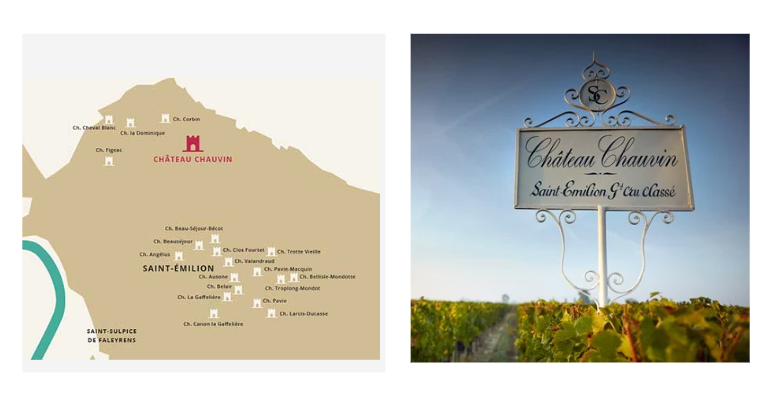
The Business
G: What are your main markets?
SC: France and Europe remain our traditional markets. England is growing steadily because my son Pierre, who lives in London, joined us after spending ten years in investment banking and is working closely with our importers, while also meeting with clubs and consumers. Chauvin is served in first class on British Airways’ long-haul flights. From the outset, I have invested heavily in the United States, a market I know well thanks to my previous roles, and we have a strong presence there. Our presence in China is still weak. However, we have developed Hong Kong and Singapore well. Finally, Africa is also an important market in which I have great faith.
G: Why do you believe so strongly in Africa?
SC: Africa is one of the emerging regions, with disparities between countries, of course. Many have a French or English culture, so they are countries where people drink wine, particularly Bordeaux wine. In addition, many African students from French-speaking countries have always come to Bordeaux to complete their studies, as it is their university of choice in France. They are our best ambassadors.
Today, these markets are also being challenged by Italian and other producers. But Bordeaux remains predominantly present there. And the standard of living is steadily increasing. Ivory Coast, for example, has become the ninth largest market in terms of volume for Bordeaux wines, and the 17th largest in terms of value. As soon as a regime becomes stable, we see a dynamic, creative youth with a real desire to do business. Things can move very quickly. The spectacular development of Ivory Coast is a good example of this.
G: In July 2024, a new sales representative joined the estate — this is a significant investment for a 15-hectare estate. Why was this decision made?
SC: My daughter Julie manages our distribution with our trading partners, but we wanted to strengthen our presence in the field by establishing direct contact with end consumers and all professionals in the various markets. We needed someone who could coordinate, follow up, monitor files, and travel if necessary.
G: How can we attract more consumers, especially Generation Z ?
SC: That’s a very good question. I believe that a real revolution is possible in this area. We have already done a lot of work on consumption patterns, particularly through convivial dinners. This formula works well and reflects our identity. Participants enjoy these moments, so we have decided to continue in this direction.
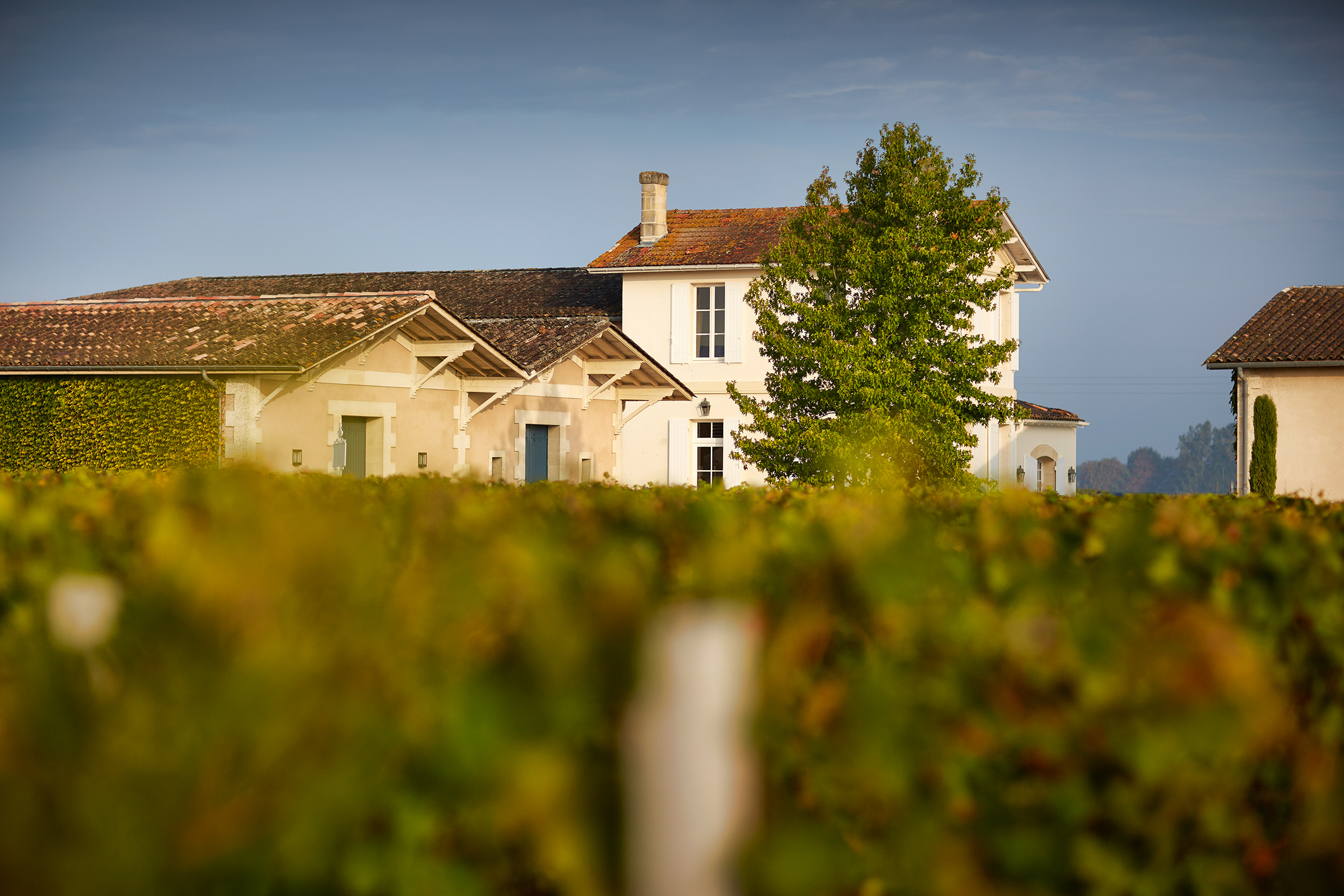
G: Especially since we produce gastronomic wines in Bordeaux.
SC: Yes, but it can also be organized around very simple and convivial things, while prioritizing impeccable quality. I don’t believe in ‘NoLo’ wines (with little or no alcohol) at all. Instead, we need to reinvent ourselves intelligently, find ways to engage with young consumers by sharing a different lifestyle, but always in their company. That’s essential.
G: Okay, but concretely, how do we go about it?
SC: I can give you two examples:
The first is the CIVB. During Wine Paris, they organized an evening event on Monday night that attracted a crowd of young people from all walks of life, including many influencers. There was karaoke, excellent wines, delicious appetizers, and above all, an incredible atmosphere. Frankly, hats off to them! It was undoubtedly the highlight of Wine Paris.
The second example concerns an operation we carried out in New York with the Crus Classés de Saint-Émilion, in partnership with a negociant. We collaborated with a distributor who sells his wines within a club whose members are young people working in the finance sector. The party took place in a huge basement, the studio of an artist exhibiting large contemporary paintings and painting live. The atmosphere was extraordinary.
We need to organize more events like this. We need to “loosen up” our events, get out from behind the table, and create fun, relaxed moments where people can taste good wines accompanied by good food. In New York, the event was so popular that the members said, “We should do this everywhere!”
G: Are these young people influenced by scores?
SC: Ultimately, they have to make a choice, so yes, in a way. But that choice may be based on a sudden preference for a blue, green, or red label… Some people are sensitive to that, but it’s not enough. Quality is important, of course, but there will always be a voice that helps them make their decision: that of the journalist, distributor, wine negociant, or sommelier. These are essential points of reference.
G: There are so many wine critics today…
SC: That’s great! We were lucky to have Robert Parker, a great wine taster to whom Bordeaux owes a great deal. He was our guide on the markets for a long time. Today, thanks to the Internet, everything moves very quickly. We zap, we share, everyone can give their opinion. So the more influencers there are, the better. Some journalists are very influential, others less so, but they speak to niche audiences, and those niches matter too. I dream of seeing one or two Indian “geeks” burst onto the market with force. Someone like Alexandre Ma on Chinese social media, for example.

Distribution Today & Tomorrow
G: How do you assess the current state of the market?
SC: Today, we have several advantages. First, the properties are in very good condition, thanks in particular to the classification system, but also to the efforts of the entire region. This focus on quality, the progress made in environmental matters, and the ability to adapt to climate change all enable us to produce very fine wines today, certainly better than in the past. We are also fortunate to benefit from international distribution. It is clear that the French market is declining every year for various reasons, largely due to the anti-alcohol lobby. The advantage of working internationally is that if one market is not performing well on a given day, we have other outlets. Bordeaux remains one step ahead of other regions. And we have the wine trade: 5,000 sales representatives travel the world to promote Bordeaux. It’s an incredible strength that exists nowhere else.
G: The Place de Bordeaux also offers real flexibility in distribution.
SC: Yes, without the Place, we wouldn’t have this international distribution network. It’s one of our pillars, especially in times of crisis. I’m convinced that it’s thanks to the Place that we’ll be able to bounce back. The wine trade has an extraordinary sales force and real expertise in the distribution of fine wines.
G: And how do you see the role of the courtiers today?
SC: Their role is essential: they know the strengths and weaknesses of each negociant, and they know what stocks are available at the estate. They support us upstream, but they are also useful to the negociant. During Primeur or deliverable tastings, courtiers are always present, even when negociants don’t have much time. They are the ones who know the diversity of our wines best.
G: In recent years, we’ve seen more non-Bordeaux wines entering the Place. What’s your take on this trend?
SC: The fact that some very fine foreign wines are sold through the Place is a real compliment to our system and strengthens it. But if the Place starts distributing all types of wines, in large quantities and not necessarily ultra-premium ones, then I think it loses its meaning.
What’s more, it disconnects the wine trade from the estates. And right now, it’s in our best interests to stick together. The wine trade is in the same boat as us. But for their part, they must remain loyal to Bordeaux. It would be a strategic mistake to bet everything elsewhere: they would become dependent on wines that don’t have our DNA. As for the campaigns, I think it’s a shame that foreign wines are now launched in April. This is the period when we are preparing our Primeurs campaign. It should be entirely devoted to us. They should keep September, I have no problem with that. But April is our moment in the spotlight. I have nothing against foreign ultra-premium wines sold via the Place, quite the contrary. But not at the expense of the Primeurs dynamic.
G: What’s your view on the En Primeur system? Should we keep it?
SC: Yes, it is essential to keep the Primeurs system, even if there is not much enthusiasm for it today and the market is no longer very keen to hold stock. But it will come back. The economy will recover, and with it, the need for stock. Some people are experiencing difficult times for the first time. I remember the 1970s, and even 1992, which were much worse.
It is important to remain confident. The Primeurs offer a unique opportunity for Bordeaux to showcase itself. It is a key moment: it allows us to engage in dialogue, promote our expertise, and introduce people to our vineyards and facilities. The market needs to take the pulse of the market, and buyers need to see our commitment on the ground.
G: Can you say a few words about wine tourism? You were a pioneer in this field with Bordeaux Saveurs.
SC: I believe in it wholeheartedly. In Saint-Émilion, the welcome at the châteaux is very professional, and the village is magnificent. It’s a memorable experience, often unforgettable. We are fortunate to have a very dynamic director of the Tourist Office, Sandrine Capdevieille. We want to develop immersive, well-designed, fun and attractive experiences. With Bordeaux Saveurs, we offer high-end, fully personalised stays. Our American clientele remains important. We work a lot with groups of friends or families, but we are increasingly collaborating with French and international companies that want to offer their employees unique and immersive experiences in the heart of the vineyards.
The Harvest 2024
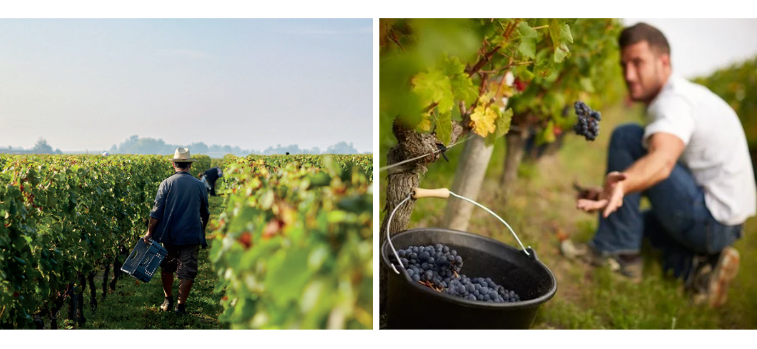
G: Could you say a few words about the harvest and your impressions of the vintage quality?
SC: 2024 is a very pleasant surprise. It’s often like this: when the market is not favorable, people tend to say the vintage is worthless—but that’s not the case here. It may not be a great vintage, but it is a vintage with freshness. We must not forget that we had a very beautiful August. Our Cabernet Francs ripened without stress. The vintage is truly very nice: balanced, with good acidity, lovely freshness, and nice fruit — not flashy, but well present.
Gerda BEZIADE has an incredible passion for wine, and possesses a perfect knowledge of Bordeaux acquired within prestigious wine merchants for 25 years. Gerda joins Roland Coiffe & Associés in order to bring you, through “Inside La PLACE” more information about the estate we sell.

